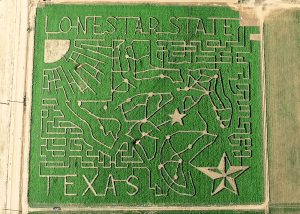
Swipe For More >
Sorghum Makes Fall Mazes More Sustainable
There’s no season that the value of agritourism becomes more evident than fall—the bustle of pumpkin patches, hayrides and mazes of…sorghum? You read that right—sorghum may just be the new corn when it comes to the whimsy of crisp, fall nights at a maze.
With increasingly intense drought conditions over the last two decades and water resources becoming scarcer, some agritourism farms are turning to sorghum to make their fall mazes more sustainable. At’l Do Farms in Lubbock, Texas, is one of those farms, making the switch in 2022.
“The [Ogallala] aquifer is depleting and becoming more mineral-dense, and the weather has been more sporadic and increasingly drier,” said Eric Simpson, co-manager of At’l Do Farms.
“A sorghum sudangrass mixture just feels way more appropriate for the area that we’re in,” Simpson continued. “[The switch to sorghum sudangrass] became solidified when the winter before that decision, we received no rain and no snowfall, so we just had no moisture to begin with.”
At’l Do Farms creates memorable family experiences for its 60,000 annual visitors during the fall season with many activities, like a pumpkin patch, cow train, petting zoo and more—but the main attraction at the farm is the maze. And while Simpson says they were nervous about the sorghum sudangrass having a negative impact on the maze experience, the switch was quite the opposite.

“We’ve found that people enjoy [the sorghum sudangrass mix] better,” Simpson said. “Whenever they’re walking through the maze now, they’re seeing things that are blooming and flowering. They’re seeing the sorghum heads turn from these slightly yellow, cream-ish colors to beautiful gold, red and sometimes black grains.”
Simpson said that the crop mix they use for the maze is primarily sorghum sudangrass, but it also includes millet, sunflowers and sun hemp. That mix creates a more resilient and lusher maze at At’l Do Farms, according to Simpson.
“It’s really keeping our maze looking like a maze until we close,” Simpson said. “It’s a much more sturdy crop. When people are walking through it, they don’t see rows like they used to see with the corn. It’s allowed us to preserve our maze longer.”
Simpson isn’t the only one who has noticed sorghum sudangrass’ benefits for fall mazes. Sweet Berry Farm in Marble Falls, Texas, also made the switch to sorghum sudangrass. According to a 2022 article from ABC 7 News in Amarillo, Texas, Sweet Berry Farm also cited sorghum sudangrass’ height, long-lasting color, drought resistance and water conservation as reasons for the maze’s switch and success.
The benefits of the sorghum sudangrass go far beyond the experiences they’re creating in their agritourism business. Simpson said they’re also seeing far less need for more intensive inputs like herbicides and fertilizers.
West Texas agritourism farms aren’t the only ones replacing corn with sorghum sudangrass. Wills Family Orchard in Adel, Iowa; Mean Greens Farm in Seymour, Missouri; Clark Farms near Vardaman, Mississippi; Poppell Farms in Odum, Georgia; Pigeon Roost Farm in Hebron, Ohio; and beyond are also making the switch. And the story is much the same between all the farms: drought, water and input costs.
Simpson, like many other agritourism farmers who have made the switch to sorghum sudangrass for their mazes, is eager to become more sustainable to keep the agritourism-focused farm thriving for generations.
“If there is to be a future in agriculture, sustainability is going to have to be at the forefront,” Simpson said. “We have people that come out to our farm year after year,” Simpson continued. “They’re getting to have the same experiences, but now it’s evolved. That gives me a lot of hope to continue to make the changes that we’re making, as far as sustainability.”
###
This story originally appeared in the Fall 2023 Issue of Sorghum Grower magazine.


